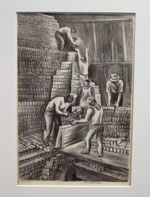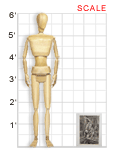From the collection of:
Clara M. Eagle Gallery, Murray State University || VAM Home
Margaret Lowengrund (American, 1902-1957)
BRICK FACTORY, 1937
Lithograph; 10" X 15"
1941.1.34
Clara M. Eagle Gallery, Murray State University
This work, which depicts five men working together to stack a seemingly endless supply of bricks, was created by realist artist Margaret Lowengrund in 1937.
About the Artist
Realist painter and printmaker Margaret Lowengrund was born in Philadelphia, Pennsylvania, in 1902. Though she studied art at the Pennsylvania Academy of the Fine Arts, she went to work as a journalist, moving to New York in 1923. She studied printmaking at the Art Students League in New York City, lithography in England with A.S. Hartick, and painting in Paris. While she was in Europe, the British Museum bought one of her lithographs. Returning to New York in 1928, she had her first one-person exhibition of prints and paintings at the Kleeman-Thorson Galleries.
Lowengrund’s success as an exhibiting artist continued in the 1930s and ’40s. She was among the printmakers in the Federal Art Project administered by the Works Progress Administration in the ’30s and was associated with the Social Realists, whose works depicted life in the American city, often with social and political commentary. One of her important contributions to the art world was the founding of a prominent New York City print shop (Contemporaries Graphic Arts Center, now the Pratt Graphics Center, associated with the Pratt Institute). She also served as associate editor of Art Digest magazine.
An ardent advocate of lithography, Lowengrund is credited with laying the groundwork for and playing a major role in the revival of printmaking after World War II. Her life and career were cut short by her death of cancer at the age of 55.
Classroom Ideas
Discussion: This print incorporates a lot of patterns and repeating rhythms. The men are even working in a rhythmic way, passing the bricks to one another. How do the rhythm and movement contribute to this piece? Do you think the artist was trying to make a social or political comment with this work? Compare this work to Jacob Lawrence’s Carpenters in the Speed Art Museum gallery.
Activities: Write a story inspired by Brick Factory. It can be about the lives of the men in the print or about the factory and its role in the town.
Choose an occupation that involves physical labor. Look at photographs of people doing this work or watch the work being done in person. Create a drawing showing the occupation you have chosen.
Links
Learn about the history of American printmaking through an exhibit from the Arizona State University art museum.
[asuartmuseum.asu.edu/historyofamericanprintmaking/]
Read the article about lithography in the ArtLex.
[www.artlex.com/ArtLex/kl/lithography.html]
Visit Nancy Lorance’s New Deal Art During the Great Depression web site for background information and lesson plans on federal art programs during the Great Depression.
[www.wpamurals.com]

